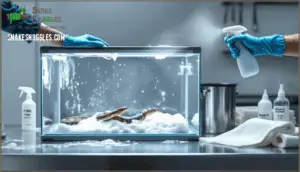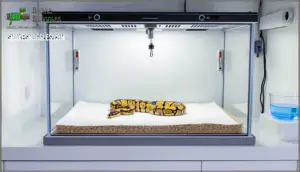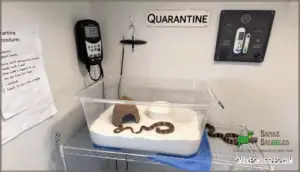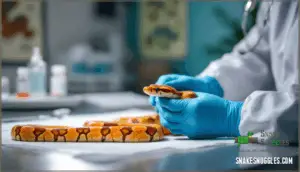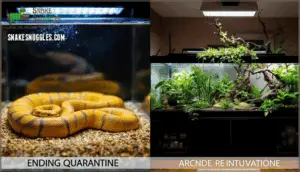This site is supported by our readers. We may earn a commission, at no cost to you, if you purchase through links.

Understanding snake quarantine procedures isn’t just about protecting individual animals; it’s about safeguarding everything you’ve built. Quarantine acts as your first line of defense, creating a controlled barrier that stops disease from reaching your healthy snakes.
This guide walks you through the specific steps that separate responsible keepers from those who learn the hard way.
Table Of Contents
Key Takeaways
- A single sick snake can silently introduce parasites, mites, and viruses that spread throughout your entire collection, making quarantine your essential first line of defense against disease outbreaks.
- Establish a completely separate quarantine space with independent ventilation, dedicated tools, and strict hygiene protocols—this setup reduces pathogen transmission risk by over 80% and prevents cross-contamination with your established snakes.
- Monitor your quarantined snake daily for health changes, conduct fecal tests every 2-4 weeks, and don’t introduce it to your collection until it passes veterinary clearance with negative disease screenings and stable weight maintenance.
- Quarantine duration depends on your snake’s origin: captive-bred from reputable breeders need 30-90 days, while wild-caught snakes require 90 days to 12 months, with the extra time catching chronic infections that asymptomatic carriers might hide.
Why Snake Quarantine is Essential
When you bring a new snake home, you’re not just adding to your collection—you’re potentially introducing unseen health threats that can devastate your established animals. Quarantine isn’t just a precaution, it’s your first line of defense against diseases, parasites, and other complications that commonly hitch a ride with new arrivals.
Quarantine is your first line of defense against disease, parasites, and health threats that new snakes commonly introduce to established collections
Here’s what you need to understand about protecting your snakes and why this step can’t be skipped.
Protecting Established Snake Collections
In every established collection, just one sick snake can become an unseen threat to all the others. That’s why quarantine procedures act as your primary defense, protecting reptiles you’ve already worked so hard to keep healthy. When you isolate new arrivals, you’re preventing parasite spread and blocking diseases like serpentovirus, which dropped from 94% in quarantined snakes to just 4% in main collections using strict biosecurity protocols.
A significant aspect involves biosecurity measures to prevent cross-contamination. Proper hygiene practices and disease prevention safeguard your investment in long-term health while dramatically reducing zoonotic risks to you and your animals.
Common Health Risks in New Arrivals
While careful biosecurity protects your collection, it’s equally important to understand what threats you’re guarding against.
Respiratory infections show up in about 20% of new snakes, often within the first two weeks. External parasites like mites appear in 15-25% of arrivals, and gut parasites affect up to a quarter of wild-caught snakes. Viral infections such as IBD strike 5-10% of new boas and pythons, while stress from transport weakens immunity in 60% of newcomers. Regular veterinary checks are also necessary during this time.
Any preexisting condition or subclinical viral pathogens can spread quickly without proper quarantine protocols.
Setting Up a Snake Quarantine Area
Setting up a proper quarantine area is the foundation of protecting your snake collection. The location, supplies, and enclosure design all work together to prevent disease transmission while allowing you to monitor your new arrival effectively.
Let’s walk through each essential element you’ll need to create a safe, functional quarantine space.
Choosing The Ideal Quarantine Location
Where should you set up your quarantine area to keep your existing snakes safe? The location matters more than you think. You’ll want to house new arrivals in a separate room or building, far from your established collection, because this physical distance cuts airborne pathogen spread by over 90%.
If space is tight, use the opposite end of your house with no shared airflow. Independent ventilation systems provide the strongest biosecurity measures, making monitoring accessibility easier while protecting your facility infrastructure during isolation and quarantine procedures.
Preparing and Disinfecting Enclosures
Proper preparation begins before your new snake arrives. You’ll need to disinfect every surface to eliminate pathogen persistence, which can last up to 16 weeks on untreated wood.
Here’s your three-step disinfection protocol:
- Scrub thoroughly with hot soapy water to remove organic buildup that weakens disinfectant efficacy
- Apply disinfectant like F10SC or a 1:30 bleach solution for 15 minutes of wet contact time
- Rinse and air-dry for at least 12 hours to prevent chemical toxicity
Let enclosures sit empty for two weeks post-cleaning before use.
Essential Supplies and Equipment
Your quarantine area needs dedicated tools and equipment to prevent disease spread. Stock non-porous enclosures like PVC or glass, paper towels for substrate, and separate plastic water bowls for each snake. Include disinfectants (F10SC or diluted bleach), spray bottles, disposable gloves, and labeled waste bins.
Install digital thermometers, thermostats, and hygrometers for environmental control. Keep records of health observations, feeding, and fecal tests.
Set up physical barriers—restricted entry points and isolated airflow—to maintain biosecurity throughout your quarantine area.
Safe Enclosure Design for Monitoring
Your enclosure’s design makes or breaks your monitoring success. Choose transparent front-facing tanks—glass or clear PVC—so you can observe behavior without handling your snake repeatedly. Position vents at top and bottom to maintain 3–6 air exchanges hourly, preventing heat buildup while keeping airflow separate from your established collection.
Space the quarantine room at least 3 meters away, with independent doors and ventilation. Install paper towels as substrate for easy daily sanitation. Keep thermometers, hygrometers, and water bowls accessible. These specifics transform your setup from basic isolation into active, hygienic surveillance.
Step-by-Step Quarantine Procedures
Now that your quarantine space is ready, it’s time to put your setup into action. The steps that follow will walk you through exactly what to do when your new snake arrives and how to keep it healthy and safe during the isolation period.
Each procedure builds on the last, so you’ll want to follow them in order to catch any problems early and prevent them from spreading to your established collection.
Isolating New Snakes Upon Arrival
When your new snake arrives, the first hours matter. Start by placing it directly into a separate, prepared quarantine enclosure—never mix it with established snakes, even briefly. This initial isolation prevents pathogen spread; studies show wild-caught reptiles carry parasites three to five times more often than captive-bred ones.
Before handling, verify the source and document arrival details. Keep your new arrival’s enclosure at least three meters away from your main collection. Minimize handling during this acclimation period to reduce stress and disease triggers.
Use dedicated tools—feeding tongs, water bowls, cleaning supplies—that never touch other snakes. This separation is your first line of defense against introducing illness into your collection.
Daily Health Monitoring and Record-Keeping
Daily observation forms your strongest defense against disease spreading through your collection. Start with visual inspections each day, watching for lethargy, wheezing, or abnormal stools—respiratory issues appear in 20–30% of newly quarantined snakes.
Track three critical metrics:
- Weight tracking (weekly, in grams): A 5–10% drop signals malnutrition or parasites
- Behavior changes: Note feeding response, shedding cycles, and defecation patterns
- Fecal assessments (every 2–4 weeks): Early detection prevents disease establishment
Document everything—even "no change" entries provide baselines. Log audits reveal subtle health trends before severe illness develops, and consistent records improve incident tracking by 40% versus informal notes. Photograph any anomalies for veterinary reference.
Feeding, Hydration, and Minimal Handling
Proper feeding and hydration form the foundation of successful quarantine—they signal how well your snake’s adapting. Wait 5–7 days after arrival before offering food, letting stress subside and reducing regurgitation risk. Then feed every 7–10 days using dedicated tongs, removing uneaten prey within 30 minutes. Fresh, dechlorinated water must stay available daily.
Minimal handling prevents stress that suppresses immunity by 40–60%, so handle only for essential health checks and cleaning. Consistent temperatures (26–32°C) and stable humidity support feeding behavior and digestion.
Document everything—appetite patterns, water intake, and stools reveal early illness before severe problems develop, keeping your collection protected.
Cleaning Protocols and Tool Separation
Think of tool separation like maintaining a firewall between quarantine and your established collection—cross-contamination can spread disease rapidly. Assign dedicated tools to quarantined snakes only: separate feeding tongs, hooks, and cleaning containers prevent pathogens from transferring between enclosures. Here’s your cleaning strategy:
- Spot-clean feces and shed skin immediately; disinfect contact surfaces (feeding ledges, hides) after each use with 0.15% bleach solution or chlorhexidine, maintaining 15-minute contact time
- Perform full enclosure disinfection weekly, soaking all equipment in disinfectant baths (70% alcohol or F10 solution) between uses
- Handle and clean quarantine enclosures last each day while wearing dedicated gloves and clothing, then shower before touching resident snakes
- Document all cleaning schedules, disinfectant concentrations, and tool assignments to maintain biosecurity integrity and traceability
This hygiene protocol reduces pathogen spread risk by over 80%, protecting your entire collection from preventable disease outbreaks.
Monitoring Health and Preventing Disease
Keeping your quarantined snake healthy requires careful observation and quick action when something seems off. During quarantine, you’ll need to watch for signs of illness or parasites, run regular fecal tests and mite checks, and know when it’s time to call your vet.
Here’s how to catch problems early and handle them safely.
Identifying Signs of Illness or Parasites
How would you know if something’s wrong with your quarantined snake? Watch for the telltale signs that separate a healthy arrival from one carrying trouble. Scale abnormalities—lesions, scabs, or dull, retained skin—signal dermatitis or dehydration. Red or black dots around the eyes and jaw point to mite infestations.
Respiratory distress shows up as wheezing, clicking, or open-mouth breathing, often indicating bacterial infection. Appetite changes and refusal to feed outside shedding cycles suggest parasites or systemic illness. Neurological signs like balance problems or unusual posturing warrant immediate attention.
These signs of reptile illness demand documentation and veterinary consultation, especially before introducing your snake to established animals. Fecal samples, collected during quarantine procedures, reveal hidden parasites your eyes can’t catch.
Conducting Regular Fecal and Mite Checks
Once visible signs appear, you’ll want to dig deeper with fecal analysis. Conduct fecal screenings every two to four weeks during quarantine—these samples reveal parasites hiding where your eyes can’t reach. Studies show 92.2% of captive snakes test positive for Salmonella, while 75% harbor protozoal infections like Caryospora. Use both flotation and sedimentation techniques to catch different parasite types; immunoassays detect Cryptosporidium missed by basic microscopy.
For mite identification, inspect your snake’s ventral scales and around the eyes—look for tiny red or black dots about 1 mm in size. Check the substrate and enclosure corners too, since female mites lay eggs there. These checks matter: untreated infestations increase secondary infections and can involve over 200 mites per snake. Your fecal samples and mite burden assessments determine whether your snake’s truly ready to join your collection.
When to Seek Veterinary Care
Your fecal and mite screenings reveal parasitic load, but they’re just part of the picture. Schedule a veterinary assessment within one week of arrival—your vet will check for dehydration, malnutrition, and systemic infections that home monitoring misses.
Watch for lethargy, anorexia, regurgitation, or swollen limbs; these signal serious illness requiring immediate care. Don’t wait for obvious signs. Early veterinary intervention catches disease before it spreads to your established collection, reducing treatment costs and preventing preventable deaths.
Managing Mite Infestations Safely
Mite infestations demand swift action once identified. Look for visible mites, dull appearance, or accumulation in protected areas like heat pits and the cloaca.
Your treatment options range from topical ivermectin to systemic selamectin applied monthly, with veterinary supervision reducing adverse outcomes by up to 50%. Combine chemical treatments with environmental controls: remove substrate entirely, clean all surfaces every 3–5 days with reptile-safe disinfectants, and use warm water soaks at 30–32°C to reduce mite loads.
Natural remedies like diatomaceous earth show only 40–60% efficacy compared to chemical agents, so they’re best as supplements. Post-treatment, continue disinfection for three weeks to prevent reinfestation from dormant eggs.
Document every treatment cycle and cleaning protocol to track mite control outcomes and prevent spread to your established collection.
Ending Quarantine and Reintroducing Snakes
You’ve successfully monitored your snake through quarantine, and now comes the critical shift: deciding when it’s truly safe to introduce your new addition to your established collection.
The following criteria will help you determine if your snake is ready to leave quarantine, along with the essential steps to take before that happens.
Recommended Quarantine Duration
How long should you really keep a new snake in quarantine? The best length depends on your snake’s origin and health status. Snakes from reputable breeders might complete quarantine in 90 days with negative testing, while wild-caught snakes require extended periods—up to 12 months.
Testing frequency matters too: plan for two to three fecal tests spaced throughout quarantine. Any visible illness restarts the clock.
Most private keepers follow a 3–6 month standard, balancing thorough disease screening against practical constraints. Longer quarantine catches chronic issues early.
Criteria for Safe Release From Quarantine
Before your snake joins the main collection, it must meet specific criteria. Your snake should have eaten at least three to four consecutive meals, maintained stable weight, and shown no signs of illness like wheezing or regurgitation.
Diagnostic testing is key: two negative fecal screenings and viral testing for pathogens confirm disease-free status.
Behavioral stability over 30 days post-feeding, along with veterinary clearance documenting environmental sanitation and absence of cross-contamination, ensures safe reintegration into your established collection.
Post-Quarantine Cleaning and Biosecurity
Once your snake clears quarantine, thorough cleaning prevents pathogens from reaching your established collection. You’ll need to execute these critical steps:
- Tool Disinfection and Waste Disposal: Soak all dedicated equipment weekly in reptile-safe disinfectant, then rinse and air-dry. Seal soiled substrate in garbage bags per local hazardous materials regulations.
- Personnel Hygiene Protocols: Change clothing and footwear after handling quarantine enclosures. Wash hands with hot, soapy water before interacting with your main collection.
- Facility Sanitation: Disinfect room surfaces weekly using bleach at 1:32 dilution or veterinary-grade solutions (15-minute contact time). Rinse thoroughly to prevent chemical residue toxicity. Never allow quarantine wastewater near other enclosures.
This rigorous approach eliminates cross-contamination risks and safeguards your entire collection’s health.
Preventing Future Health Issues
Your quarantine doesn’t end when the snake leaves isolation—it continues through vigilant long-term practices. Implement proactive screening with veterinary checkups every six months to catch subclinical infections before they spread.
Improve diet and environmental enrichment to minimize stress-induced immune suppression, which can trigger latent disease in up to 50% of newly introduced snakes.
Maintain permanent tool segregation between collections, reducing pathogen transmission by 88%. Document health records carefully; written tracking improves early identification of recurring issues by 30%.
These preventative measures transform quarantine best practices into a permanent biosecurity culture, safeguarding your collection indefinitely.
Frequently Asked Questions (FAQs)
How long should quarantine last for different snake species?
Different species require different quarantine lengths based on disease risk. Captive-bred snakes generally need 30 to 60 days, while wild-caught snakes require 90 days to 6 months. Pythons and boas warrant extended periods—up to 6 months—due to susceptibility to serious diseases like Inclusion Body Disease, which has incubation periods extending months.
Internal parasites demand repeated testing over weeks, justifying longer quarantine durations for thorough screening and safe reintroduction.
Can quarantined snakes be housed together temporarily?
No. Co-housing quarantined snakes dramatically increases pathogen transmission risk. Studies show new collections carry infectious agents in up to 70% of cases. Asymptomatic carriers spread diseases silently, complicating diagnosis.
Expert guidelines universally prohibit co-housing during quarantine due to bacterial, fungal, and parasitic cross-contamination risks. House each snake separately.
What specific tests confirm a snake is disease-free?
You’ll want definitive confirmation before integrating any new snake into your collection. Molecular diagnostics like PCR testing detect viral infections with over 90% accuracy, while serological tests identify antibody responses to past exposures. Fecal screenings reveal parasitic infections, and histopathology methods confirm tissue changes from disease.
Your veterinarian combines these sampling methods—blood draws, cloacal swabs, and fecal analysis—to establish disease-free status comprehensively before quarantine release.
How do I safely introduce a snake post-quarantine?
Introduce your snake gradually over 1-2 weeks, allowing it to remain in its enclosure while accessing the new habitat. Minimize handling during the initial introduction, maintain temperature gradients (90-92°F basking, 70-85°F ambient), and keep humidity between 60-80%.
Conduct weekly health surveillance checks for the first month, monitoring for discharge, swelling, or abnormal behavior. Use dedicated equipment and implement established reptile handling protocols to prevent cross-contamination with other snakes.
Should I quarantine captive-bred snakes from reputable breeders?
Yes, quarantine captive-bred snakes from reputable breeders. While breeder health standards reduce risk, studies show about 30% of captive snakes carry Salmonella asymptomatically, and 5% carry inclusion body disease.
Asymptomatic carriers and latent infections mean even healthy-looking snakes can transmit pathogens.
A 30–90 day quarantine duration with fecal testing provides essential preventative measures, protecting your established collection from disease introduction.
Conclusion
You might worry that quarantine takes too much time and space, but think of it as an investment that pays dividends across your entire collection.
Understanding snake quarantine procedures isn’t complicated—it’s a straightforward system that catches problems before they spread. By following these steps consistently, you’re not just protecting individual snakes; you’re building a resilient, healthy collection that thrives for years.
The extra effort now prevents catastrophic losses later.
- https://azeah.com/reptiles-amphibians/quarantine-guidelines-reptile-owners
- https://www.sciencedirect.com/science/article/abs/pii/S1090023307000123
- https://www.merckvetmanual.com/exotic-and-laboratory-animals/reptiles/management-and-husbandry-of-reptiles
- https://www.reptilerescuecenter.org/articles/quarantine/
- https://showmereptileshow.com/resources/the-importance-of-quarantining-new-reptiles-ensuring-a-healthy-collection


